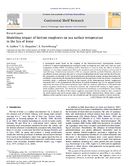Modelling impact of bottom roughness on sea surface temperature in the Sea of Iroise/ en
 Language: Language: |
Français |
Published in 2013 in Continental Shelf Research, vol. 54, 80-92, doi:10.1016/j.csr.2012.12.003
Nicolas Guillou et Georges Chapalain
Laboratoire de Génie Côtier et Environnement (LGCE)
Centre d'Etudes Techniques Maritimes Et Fluviales (CETMEF)
Eric Duvieilbourg
Laboratoire des Sciences de l'Environnement Marin, UMR 6539, Institut Universitaire Européen de la Mer, Plouzané, France.
Keywords
Ushant front; Tide; Wave; COHERENS; SWAN; SIRANO.
Abstract
A hydrological model based on the coupling of the three-dimensional hydrodynamic module COHERENS (COupled Hydrodynamical–Ecological model for RegioNal and Shelf seas) with the wave propagation module SWAN (Simulating WAves Nearshore) is used to study the effects of bottom roughness on sea surface temperature (SST) in the nearshore areas of the Sea of Iroise (western end of french Brittany). Predicted time histories of SST are compared with the available field data collected at two offshore stations and along the route of a vessel travelling between the coast and the isle of Ushant. The comparison is extended to SST spatial distribution derived from remote-sensing observations for conditions characterising the development of horizontal thermal fronts in the Sea of Iroise. A numerical sensitivity study is conducted focusing on the impacts of the heterogeneous bottom roughnesses associated with (i) the granulometric distribution of seabed sediments and (ii) the apparent friction induced by the waves in the bottom boundary layer. Whereas moderate differences are obtained, both bottom-roughness distributions are found to influence the predicted SST leading to slight improvements of global predictions. The sensitivity of numerical simulations is exacerbated in areas of high thermal gradients. The effects of the bottom roughness associated with the seabed are thus revealed at the north-eastern and south-eastern edges of external Ushant thermal front. Waves have a major influence in the nearshore areas of the bay of Audierne and the western extend of Crozon peninsula.
 S'abonner à un flux RSS
S'abonner à un flux RSS
